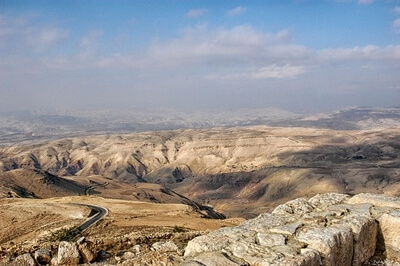Jordan Valley
The Jordan Valley stretches along the Jordan Rift Valley with the Upper Jordan Valley running from northern Israel through Hula Valley and to the Sea of Galilee’s northern shore and the Lower Jordan Valley running from the Sea of Galilee to the Dead Sea in the south. The “Jordan Valley” often refers just to the Lower Jordan Valley. The valley forms the natural border between Jordan to the east and Israel and the West Bank to the west.
 The valley has steep escarpments on both sides; abundant water sources including the Jordan River; an agricultural climate and rich fertile soil. In the lower regions of the valley towards the Dead Sea the terrain changes and is mostly arid, hot desert. The lowest part of the valley is at the Dead Sea, where the shore is 400 m below sea level, the lowest point on Earth. The Jordan River runs the length of the valley from its sources in northern Israel south into and out of the Sea of Galilee and further south into the Dead Sea.
The valley has steep escarpments on both sides; abundant water sources including the Jordan River; an agricultural climate and rich fertile soil. In the lower regions of the valley towards the Dead Sea the terrain changes and is mostly arid, hot desert. The lowest part of the valley is at the Dead Sea, where the shore is 400 m below sea level, the lowest point on Earth. The Jordan River runs the length of the valley from its sources in northern Israel south into and out of the Sea of Galilee and further south into the Dead Sea.
Inhabitants of the Jordan Valley
The valley is home to 7,000-11,000 Jews and 56,000-65,000 Palestinians. Large communities include about 28 Jewish cities like Beit Shean, Megiddo, Mehola, Ma’aleh Ephraim, and Bekaot. There are about 10 Palestinian cities including Jericho. Jericho is one of the largest Palestinian cities in the Jordan Valley.
Jordan Valley in the Bible
The Old Testament refers to the Jordan Valley several times mentioning its fertile lands and miracles that took place in the valley. When the Israelites crossed over the Jordan River into the Promised Land they arrived in the Jordan Valley at Qasr el-Yehud. It was at the same site that Christians believe John the Baptist baptized Jesus. This site is now a tourist destination where it is possible to be baptized in the Jordan. Another possible baptismal site is Yardenit located further north near the Sea of Galilee.
History of the Jordan Valley
The Jordan Valley became part of the Ottoman Empire in 1486. World War I ended Ottoman rule in Palestine and the British and French divided the spoils resulting in the Jordan Valley becoming British territory in 1918. The land east of the Jordan River became the Emirate of Transjordan and the valley west of the river was part of the British Mandate of Palestine.
In 1947 following WWII the UN assigned the northern portion of the valley to the new Jewish state and the southern portion to a new Arab state.
However, the surrounding Arab nations did not support this plan and attacked Israel sparking the 1947-48 Israeli War of Independence. During the war, Israel managed to push back the invaders on all fronts however the Jordanians managed to keep control of both sides of the Jordan Valley along the West Bank/Jordanian border. From 1948 to1967 Jordan controlled the valley and prohibited Jewish settlements. In the 1967 Six-Day War Israel captured most of the Jordan Valley.
The Jordan Valley Today
Since the 1967 war relations have been good between Jordan and Israel across the Jordan Valley. In the 1990s the Oslo Accords gave Israel administration over most of the valley and placed about a quarter of Palestinian territory of the West Bank within the Jordan Valley. Over the years several Jewish settlements have been established in the Jordan Valley’s Israeli-administrated “Area C” while the Palestinian government controls all areas of the valley in “Area A.”
Israel is reluctant to give up the Jordan Valley because of its vital water sources and its high ridges which offer a natural defensive barrier. If war were to break out between Israel and its neighbors to the east the Jordan Valley would be a vital defense line. Today there are border posts in the Jordan Valley into the Palestinian West Bank and the Allenby Bridge Border Crossing into Jordan. The valley’s beauty and historic landmarks make it a popular destination for travelers.
 Login / Register
Login / Register
 Contact Us
Contact Us
 Certificate of Excellence
Certificate of Excellence Guaranteed Departure
Guaranteed Departure Low Prices Guaranteed
Low Prices Guaranteed 24/7 Support
24/7 Support




